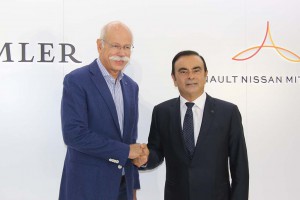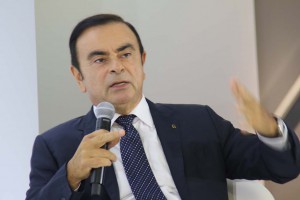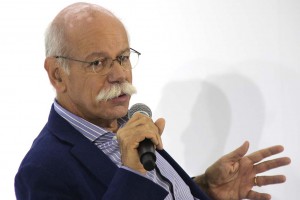
Zetsche and Ghosn first met when the German exec was working at Freightliner and the Brazilian-born Ghosn worked for Michelin.
Since launching the first in a broad series of joint ventures nine years ago, Daimler AG and the Nissan/Renault/Mitsubishi Alliance have generated what they claim to be billions of dollars in “synergies” that have allowed them to expand their product lines and grow into new markets.
But in recent months, the future of that partnership has come under question. The last major new project was announced three years ago. And now, with Daimler Chief Executive Dieter Zetsche planning to relinquish the CEO title next year, that has raised new questions about whether his successor, Ola Kallenius, would keep the alliance going.
“Without the chemistry between us, maybe this wouldn’t have happened,” said Zetsche, during a joint news conference with Nissan/Renault/Mitsubishi Alliance chief Carlos Ghosn. But considering the results the partnership has generated, “I don’t see from my perspective why the momentum in this relationship should change.”
For his part, Ghosn echoed that position, suggesting that Kallenius has already had a role in the four-manufacturer partnership in his current role at Daimler, earning respect from all sides.
When it was formed, nearly a decade ago, originally pairing what was then the Nissan/Renault Alliance and Daimler, such collaborations were a rarity. Today, in an industry facing immense pressures on trade, as well as the need to develop radical – and costly – new technologies, partnerships among erstwhile competitors have become much more the norm. Honda and General Motors, for example, are working on the development and production of fuel cells. Toyota and BMW jointly developed the platform that will become the next BMW Z4 and Toyota Supra.
Their own alliance has made it possible to produce new minicars, such as the Renault Twingo, and to help Mercedes-Benz and Infiniti start producing luxury cars at a plant in Mexico, Ghosn and Zetsche agreed during the latest in a series of joint news conferences that have come to be known as “The Carlos and Dieter Show.” That said, some observers have speculated that the original enthusiasm is winding down, pointing to the fact that no new joint ventures have been unveiled in several years.
The two CEOs agreed they aren’t willing to reveal what they’re working up now, but hinted there just might be more coming. And Zetsche stressed that it’s normal to begin any partnership with a burst of activity that will slow as the relationship “matures.”
That said, “I can tell you the synergies we developed here are significant and can go further,” Ghosn quickly injected.
What areas might be under study? For his part, the Daimler CEO said he hates “blank spaces,” including market segments where his company isn’t participating. But considering the breadth of its latest product offerings, are they any niches left? “Perhaps a roto-copter,” Zetsche responded, a concept that Daimler is actually already working on, albeit with a different partner.
Perhaps the more likely focus would be in areas described by the acronym, CASE, short for Connected, Autonomous, Shared and Electric vehicles, the two CEOs agreed. They’ve already pushed into those areas with earlier joint ventures. Two examples are the battery-powered versions of the Renault Twingo and the Smart Fortwo. But with autonomous and electric vehicles expected to become critical elements of tomorrow’s auto industry, Zetsche and Ghosn did everything but confirm they are exploring new collaborations.
Perhaps, but industry observers were surprised when the Renault/Nissan/Mitsubishi Alliance last month announced it would partner with Google to develop a voice assistant-controlled infotainment system for future vehicles, rather than use the similar MBUX technology Mercedes just started rolling out in its next-generation A-Class line.
The push into electric power comes at the same time the overall industry is examining the future role of diesel power. Sales have been in flux since the September 2015 revelation that Volkswagen had cheated on emissions tests, a scandal so far costing it about $30 billion. This week, Audi CEO Rupert Stadler was fired and he remains in jail, accused of helping to cover up the cheating.
Daimler has also come under suspicion over emissions levels from some older diesels, but Zetsche insisted the new engines developed in partnership with Renault/Nissan are all but just as clean as modern gasoline engines. The problem is cost. And the fact that they are more expensive means they will largely apply to mid- and higher-end Mercedes-Benz models going forward. Its partner however is “going to reduce our exposure to diesels,” since, Ghosn said, the higher costs would be less appealing to Renault, Nissan and Mitsubishi buyers.
Sharing costs on development of diesels, as well as new technologies like batteries and electric motors, will help the partners justify working together in the future, Ghosn and Zetsche agreed. They also pointed to the various political issues facing the industry over topics as diverse as trade and emissions. Automakers, declared Ghosn, “don’t like uncertainty.”
Both men said they were pleased to see the U.S., Canada and Mexico come up with an apparent resolution to the Trump Administration’s threat to kill the North American Free Trade Agreement
In the meantime, they will have to wait to see what happens as the Brexit negotiations move towards an expected conclusion next March. For his part, Ghosn said he does not expect a “hard exit” that would create chaos for businesses operating in Britain. On the other hand, he prefers to “be prepared for the worst and hope for the best.”
And that, the two CEOs suggested, is why it make sense for two strong partners to continue working together. They can look for opportunities that can emerge from even the worst crisis.


